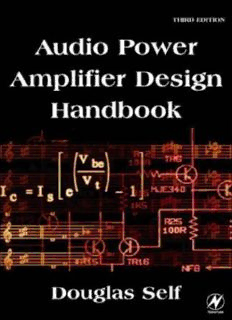
Audio Power Amplifier Handbook, 3rd edition PDF
Preview Audio Power Amplifier Handbook, 3rd edition
Audio Power Amplifier Design Handbook Audio Power Amplifier Design Handbook Third edition Douglas Self MA, MSc Newnes OXFORD AMSTERDAM BOSTON LONDON NEW YORK PARIS SAN DIEGO SAN FRANCISCO SINGAPORE SYDNEY TOKYO Newnes An imprint of Elsevier Science Linacre House, Jordan Hill, Oxford OX2 8DP 225 Wildwood Avenue, Woburn MA 01801-2041 First published 1996 Reprinted 1997, 1998 Second edition 2000 Reprinted 2000 Third edition 2002 Copyright © 1996, 2000, 2002, Douglas Self. All rights reserved The right of Douglas Self to be identified as the author of this work has been asserted in accordance with the Copyright, Designs and Patents Act 1988 No part of this publication may be reproduced in any material form (including photocopying or storing in any medium by electronic means and whether or not transiently or incidentally to some other use of this publication) without the written permission of the copyright holder except in accordance with the provisions of the Copyright, Designs and Patents Act 1988 or under the terms of a licence issued by the Copyright Licensing Agency Ltd, 90 Tottenham Court Road, London, England W1T 4LP. Applications for the copyright holder’s written permission to reproduce any part of this publication should be addressed to the publisher British Library Cataloguing in Publication Data A catalogue record for this book is available from the British Library ISBN 0 7506 56360 For information on all Newnes publications visit our website at www.newnespress.com Composition by Genesis Typesetting, Rochester, Kent Printed and bound in Great Britain Contents Synopsis vii Preface xv 1. Introduction and general survey 1 2. History, architecture and negative feedback 30 3. The general principles of power amplifiers 60 4. The small signal stages 73 5. The output stage I 106 6. The output stage II 163 7. Compensation, slew-rate, and stability 183 8. Power supplies and PSRR 235 9. Class-A power amplifiers 255 10. Class-G power amplifiers 290 11. FET output stages 314 12. Thermal compensation and thermal dynamics 325 13. Amplifier and loudspeaker protection 370 14. Grounding and practical matters 396 15. Testing and safety 418 Index 423 v Synopsis Chapter 1 Introduction and general survey The economic importance of audio amplifiers There are no practical textbooks Knowledge assumed Origins and aims The study of amplifier design Some new findings in amplifier design A snapshot of the technology No inspiration from IC technology Aimed at discrete amplifiers Amplifiers are now designable Misinformation in audio Science and subjectivism The Subjectivist position A short history of subjectivism The limits of hearing Articles of faith: the tenets of subjectivism The length of the audio chain The implications The reasons why The outlook Technical errors The performance requirements for amplifiers Safety Reliability Power output and load capability Frequency response Noise Distortion Damping factor Absolute phase Acronyms vii Synopsis Chapter 2 History, architecture and negative feedback A Brief History of Power Amplifiers Power amplifier architectures The three-stage structure The two-stage amplifier structure Power amplification classes Class-A Class-AB Class-B Class-C Class-D Class-E Class-F Class-G Class-H Class-S Variations on Class-B AC and DC coupled amplifiers The advantages of AC-coupling The advantages of DC-coupling Negative feedback in power amplifiers Some common misconceptions about negative feedback Amplifier stability and NFB Maximising the NFB factor Linearising before adding NFB Chapter 3 The general principles of power amplifiers How a generic power amplifier really works The advantages of the conventional The eight distortions The performance of a standard power amplifier Determining open-loop non-linearity Direct open-loop gain measurement The use of ‘model’ amplifiers The concept of the Blameless amplifier Chapter 4 The small signal stages The role of the input stage Three kinds of differential input stage BJTs versus FETs for input stages Singleton versus differential input stages Measuring input stage distortion in isolation viii Synopsis Importance of input stage balance Use of current-mirrors Constant-gm degeneration Radical methods of improving linearity Input stage cascoding Input noise and how to reduce it Input balance and DC offset The input stage and the slew-rate The voltage-amplifier stage Measuring VAS distortion in isolation VAS operation VAS distortion Linearising the VAS: active-load techniques Enhancements to the basic VAS The importance of voltage drive The Balanced VAS The VAS and the manipulation of open-Loop bandwidth Manipulating open-loop bandwidth Conclusions Chapter 5 The output stage I Classes and devices The distortions of the output Harmonic generation by crossover distortion Comparing output stages The Emitter-Follower output configuration The Complementary-Feedback-Pair output configuration Quasi-Complementary output stages Output triples Triple EF output stages Distortion and its mechanisms Large-signal distortion The load-invariant concept The LSN mechanism Doubled output devices Better output devices Feedforward diodes Trouble with triples Loads below 4(cid:2) Better 8-(cid:2)performance A practical load-invariant design The latest findings Summary Crossover distortion Switchoff distortion ix
Description: